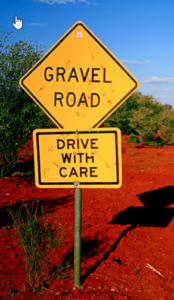As safety is always our number one priority. We want to make sure everyone is alive and well. Gravel roads can be like driving on marble and we wouldn’t want you to loose control. Please don’t exceed 15 MPH. Driving fast can also cause a huge dust cloud causing someone to not be able to see. Make sure to have fun and stay safe.
Please keep in mind that if you use 4 wheel drive at all times on the roads it will help keep the washboards effect down.
Maintenance
 Gravel roads require much more frequent maintenance than paved roads, especially after wet periods and when accommodating increased traffic. Wheel motion shoves material to the outside (as well as in-between travelled lanes), leading to rutting, reduced water-runoff, and eventual road destruction if unchecked. As long as the process is interrupted early enough, simple re-grading is sufficient, with material being pushed back into shape.
Gravel roads require much more frequent maintenance than paved roads, especially after wet periods and when accommodating increased traffic. Wheel motion shoves material to the outside (as well as in-between travelled lanes), leading to rutting, reduced water-runoff, and eventual road destruction if unchecked. As long as the process is interrupted early enough, simple re-grading is sufficient, with material being pushed back into shape.
Segments of gravel roads on grades also rut easily as a result of flowing water. When grading or building the road, water bars are used to direct water off the road. As an alternative method, humps can be formed in the gravel along the road to impede water flow, thereby reducing rutting.
Another problem with gravel roads is washboarding — the formation of corrugations across the surface at right angles to the direction of travel. They can become severe enough to cause vibration in vehicles so that bolts loosen or cracks form in components. Grading removes the corrugations, and reconstruction with careful choice of good quality gravel can help prevent them reforming. Additionally, installing a cellular confinement system will prevent the washboard-like corrugations from occurring.
Gravel roads are often found in cold climates because they are less vulnerable to freeze / thaw damage than asphalt roads. The inferior surface of gravel is not an issue if the road is covered by snow and ice for extended periods.
Driving
Although well-constructed and graded gravel roads are suitable for speeds of up to 60 mph, driving on them requires far more attention to variations of the surface and it is easier to lose control than on a paved road. In addition to potholes, ruts and loose stony or sandy ridges at the edges or in the middle of the road, problems associated with driving on gravel roads include:
- sharper and larger stones cutting and puncturing tires, or being thrown up by the wheels and damaging the underside, especially puncturing the fuel tank of unmodified cars
- stones skipping up hitting the car body, lights or windshields when two vehicles pass at high speed
- dust thrown up from a passing vehicle reducing visibility
- ‘washboard’ corrugations cause loss of control or damage to vehicles due to excessive vibration. These are most often found near intersections as stopping or braking causes them to form or otherwise if heavy farm or other equipment often uses these roads.
- skidding on mud after rain
- vehicle fishtailing as a result of ruts in the surface of the gravel. Often found on frequently traveled roads
- In higher rainfall areas, the increased camber required to drain water, and open drainage ditches at the sides of the road, often cause vehicles with a high centre of gravity, such as trucks and off-road vehicles, to overturn if they do not keep close to the crown of the road
- Excess dust permeates door-opening rubber moulding breaking the seal
- Lost binder in the form of road dust, when mixed with rain, will wear away the painted surfaces of vehicles
- Many gravel roads are only one lane wide or slightly larger, thus requiring special attention when driving at higher speeds
Comments concerns please Contact Us.